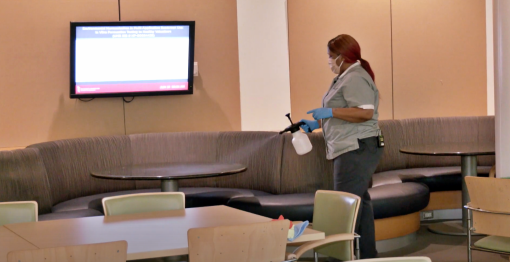Inside Pharmacy Hall, the sounds of students and faculty bustling through the hallways are replaced by air squeaking through pump bottles, releasing a fine mist.

UMB Environmental Services technician Sierra Tyler applies a new EPA-registered disinfectant chemical using a pump spray bottle inside Pharmacy Hall. This spray has a 10-minute dwell time and is used for surface cleaning for COVID-19.
It’s a common scene this summer throughout the University of Maryland, Baltimore (UMB) to see a lone employee walk through grand spaces, past empty tables, performing what looks like a ballet: twisting, pivoting, and deftly applying cleaning and disinfecting chemicals with grace to keep UMB healthy.
Sierra Tyler, an Environmental Services (EVS) technician, does this dance every day to keep ahead of the increasing foot traffic and hands leaving their mark on high-touch surfaces. As she waits for the disinfecting spray to set for 10 minutes on a chair, Tyler will turn her attention to a table. When the spray is set, she’ll use a color-coded microfiber rag for the job.
Blue for dusting and windows. Green for tables, door handles, microwave handles, elevator buttons and doors, and handrails. Yellow for sinks and mirrors in restrooms. Red for toilets and urinals.
With campus being virtually a ghost town as most employees telework, what Tyler lacks is a dance partner to maneuver around and chat with.
“I’m used to talking to someone, ‘How’s your day going on?’” she said. “In here, it’s like ‘How are you doing, Sierra?’ I’m talking to myself. I’m echoing. It’s quiet. I’ve been here nine years, and this is the first time I ever experienced it.”
It is employees like Tyler who are keeping UMB clean every day with a heightened sense of awareness of COVID-19. The EVS crew is equipped with new tools and procedures so employees are ensured their health is a top priority when it comes to cleaning.
That four-colored microfiber rag system and hand-pump bottle are two of the new tools that EVS technicians are using now to make their job easier and reduce cross-contamination. Inside the bottle is a new chemical. It is a non-bleach, fine-mist disinfectant spray for surfaces approved by the Environmental Protection Agency for use for COVID-19. In the restrooms, disposable toilet brushes are now used.
As EVS cleans with enhanced procedures, EVS associate director Denise Meyer remarked that the “bar’s raised.”
Each EVS employee completed a 12-point training for COVID-19 related cleaning and disinfecting. Part of the training includes higher frequency of cleaning.
“It is our intent to have a person designated for high-touch cleaning in all of our buildings,” she said. “That would be their job all day.”
Restroom cleaning and disinfecting is being increased to twice daily, Meyer added.
As operations in research laboratories returned to 25 percent capacity as of June 8, it was the first sign of some life returning to buildings. EVS, as well as Environmental Health and Safety (EHS), are focusing on guidance to clean high-touch surfaces, common areas, and research laboratories.
The laboratories are focused on researchers taking care of their own spaces because of the nature of their work. The push for researchers is to account for staggering shifts, physical distancing, and wearing masks or personal protective equipment (PPE) if areas were not required before and in common areas.
EHS director Steven Deck, DM, MBA, emphasized wearing of masks in common areas and interacting with employees as well as hand washing.
“Hand washing is still preferred over the hand sanitizer,” Deck said. “The washing gets the build-up off.”
Employees should take note of new signage throughout buildings that limit capacity and traffic flow, Meyer said. Steps may be up-only or down-only. Elevators and restrooms will have capacity limitations marked. Sinks and urinals may have tape over the bowls and stalls may be locked to achieve physical distancing in restrooms.
Cleaning did not idle while many employees were away. Fewer people occupying spaces means an opportunity for a deep cleaning.
“We’re able to get things that we might not been able to sanitize because certain people might not be able to be around certain chemicals or it’s just a high-touch area that someone is always in,” she said, citing kitchens as an example. “So, it’s been very good to get to those areas you really can’t get to.”
If anyone has any hesitation on how clean campus is, know that Tyler takes cleaning personally.
“At the end of the day when I leave here, if I didn’t clean well, I’m taking germs from here, home,” she said. “I have to do my job here in order to keep home safe. That’s the No. 1 priority. Work needs to be safe in order for home to be safe, especially during times like this.”


